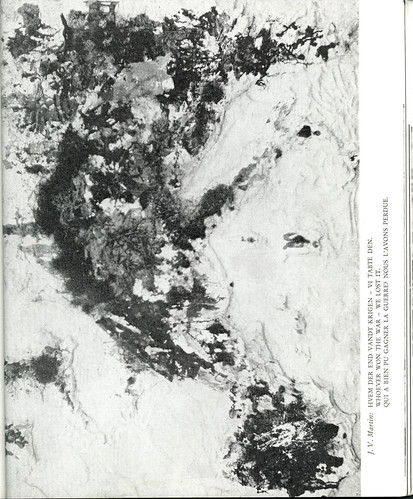The audience were told to fire rifles at the pictures and obtained a free copy of the catalogue if they managed to hit the eye of one of the politicians. On the wall next to the targets a series of so-called directives made by Debord hung. The directives were white canvases on which Debord had written slogans like: “Abolition du travail aliènè” (Abolition of alienated labour). In the next room J. V. Martin’s ‘thermonuclear maps’ hung. The maps were large paintings that depicted the world after the outbreak of the third world war.
The audience were told to fire rifles at the pictures and obtained a free copy of the catalogue if they managed to hit the eye of one of the politicians. On the wall next to the targets a series of so-called directives made by Debord hung. The directives were white canvases on which Debord had written slogans like: “Abolition du travail aliènè” (Abolition of alienated labour). In the next room J. V. Martin’s ‘thermonuclear maps’ hung. The maps were large paintings that depicted the world after the outbreak of the third world war.
The manifestation was conceived as a continuation of the action undertaken two months prior to the opening of the manifestation by a group of British activists calling themselves Spies for Peace. The British activists had broken into a secret shelter called RSG-6 in Reading where the British government had planned to hide in case of a nuclear attack. Following their discovery of the plans of the government the activists had published a small pamphlet in which they made public these plans and the existence of secret shelters reserved for politicians and civil service personnel. The events following the publication of the pamphlet causing a scandal in Britain attracted considerable attention and the situationists were not late in responding.
N JUNE 1963 the SI organized a ‘Destruction of RSG-6’ demonstration in Denmark, under the direction of J.V. Martin. On this occasion the situationists distributed a clandestine reissue of the English tract Danger: Official Secret-RSG 6, signed ‘Spies for Peace,’ which revealed the plan and function of ‘Regional Seat of Government #6.’ A theoretical text, The Situationists and the New Forms of Action in Politics and Art, was also issued in Danish, English and French. In one area an ugly reconstruction of a bomb shelter was set up; in another were exhibited Martin’s ‘Thermonuclear Maps’ (détournements of Pop Art representing various regions of the globe during World War III).
http://arttorrents.blogspot.com/2007/04/destruction-of-rsg-6.html


